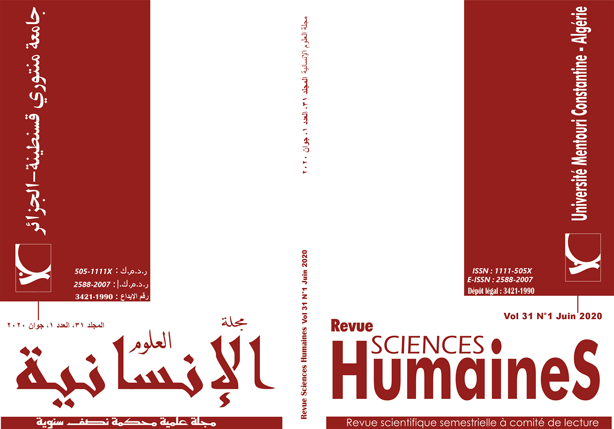النزاع السوري: قراءة في الأبعاد و التداعيات الإقليمية
الكلمات المفتاحية:
النزاع السوري، الشرق الأوسط، تركيا، إيران، دول الخليجالملخص
تسعى هذه الدراسة إلى تسليط الضوء على النزاع السوري ومدى تأثيره على دول الجوار الإقليمي العربية و غير العربية ، ومختلف القوى الإقليمية، التي ساهمت بشكل مباشر في تغيير مسار النزاع السوري الداخلي ما بين داعم للمعارضة السورية ومؤيد للنظام السوري، وما نتج عن هذا اتساع دائرة الجماعات المتطرفة و الانفصالية في ظل تنامي النزعات الطائفية التي أصبحت كعامل محدد يُفهم من خلاله طبيعة النزاعات التي تعرفها منطقة الشرق الأوسط، فضلا على أن النزاع السوري يعتبر عاملاً مرجّحًّا في توازنات المنطقة، وما سوف يكون له من آثار حاسمة في تحديد مآلاته ومساراته التي يمكن أن يسلكها مستقبلا.
التنزيلات
المراجع
- Lund Aaron, “How Assad’s Enemies Gave Up on the Syrian opposition”, The Century Foundation, retrieved from: https://tcf.org/content/report/assads-enemies-gave-syrian-opposition/?agreed=1
- Oktav Ozden Zeyneb, (2015), “The Syrian Civil War and Turkey-Syria-Iran Relations”, Syria Studies, , P06.
- Tahiroglu Merve and Gabel Andrew, “Saving Northeastern Syria: How Washington Can Help Strike a Deal Between Turkey and the Kurds”, Foreign Affairs, April 9th, 2019. From: https://www.foreignaffairs.com/articles/turkey/2019-04-09/saving-northeastern-syria
- Altunisik Meliha Benli, (2016), “Turkey at a Crossroads: The Inflexibility of Turkey’s Policy in Syria”, Ankara, Turkey, Department of International Relations Middle East Technical University, p39.
- Akturk Sener,( 2017), “Turkey’s Role In The Arab Spring And The Syrian Conflict”, Turkish Policy Quarterly, Volume 15 Number 4, Winter, p88.
- Guzansky Yoel,( 2015), “The Arab Gulf States and Reform in the Middle East: Between Iran and Arab Spring”, London, UK, Palgrave Macmillan, p40.
- Goodrazi Jubin, “Iran and Syria: The Iran Primer”, United States Institute of Peace, retrieved from:
https://iranprimer.usip.org/resource/iran-and-syria
- Frederic M. Wehrey, (2014), “Sectarian Politics in the Gulf: From Iraq War to the Arab uprisings”, New York, USA, Columbia University Press, p44.
- Guzansky Yoel, (2015), “The Arab Gulf States and Reform in the Middle East: Between Iran and Arab Spring”, London, UK, Palgrave Macmillan, p39.
- Ma’oz Moshe, (2007),“The Shii Crescent: Myth and Reality”, the Saban Center in Brookings Institution, analysis paper, , Number15, November, p07.
- Walker Martin,(2006), “The Revenge of the Shia”, Wilson Quarterly, autumn.
- Kristian Ulrichsen, (2009), “Gulf Security: Changing internal and external dynamics”, The Center for The Study of Global Governance, May, pp11-12.
- Hydemann Steven, (2013), “Syria’s Uprising: Sectarianism, regionalization, and State order in the Levant”, working paper, N°119, May, p10.
- Catar Sabina, (2015),“Kurdish Political Parties in Syria” in Wolfgang Taucher and others “The Kurds: History, Religion, Language, Politics”, , Austria, Austrian Federal Ministry of the Interior, p112.
- Schmidinger Thomas, (2018), “Rojava Revolution, War and the Future of Syria’s Kurds”, London, UK, Pluto Press, p79.
- Harriet Allsopp,(2015), “The Kurds of Syria: Political Parties and Identity in the Middle East”, London, I.B.Tauris and Co Ltd, p15.
- Gunes Cengiz and Robert Lowe, (2015),“The Impact of the Syrian War on Kurdish Politics across the Middle East”, London, UK, Research Paper, Middle East and North Africa Programme, the Royal Institute of International Affairs, Chatham House, , July, p04.
- Gunes Cengiz, (2019), “The Kurds in New Middle East: The Changing Geopolitics of a Regional Conflict”, London, UK, Palgrave Macmillan, p61
- Bengio Ofra,(2014), “The Islamic State: A Catalyst for Kurdish nation-building”, TelAviv Notes, Vol 08, N°18, 07th October ,The Moshe Dayan Center for Middle Eastern and African Studies p04.
- Bengio Ofra, Ibid, pp03-04.
- William Harris, (2018), “Quicksilver War: Syria, Iraq and the Spiral of Conflict”, New York, US, Oxford University Press, p105.
- Osoegawa Taku, (2013), “Syria and Lebanon: International relations and Diplomacy in the Middle East”, London, UK, I.B.Tauris, p91.
- Osoegawa Taku Osoegawa, op cit.
- International Crisis Group, (2012),“A Precarious Balancing Act: Lebanon and the Syrian conflict”, Middle East report N°132, p01.
- International Crisis Group,(2014), “Lebanon’s Hezbollah turns Eastward to Syria”, Middle East report, N°153, May 14th, p18.
- Philips Christopher, (2015), “Sectarianism and conflict in Syria”, Third world quarterly, London, UK, Queen Mary, university of London, Vol.36, N°2, 357-376, Routledge, 14th May , p 359.
- Ibid.
- International Crisis Group, “A Precarious Balancing Act: Lebanon and the Syrian conflict”, op.cit
- Bahout Joseph, (2014),“Lebanon at the Brink: The Impact of the Syrian Civil War”, , Brandies University, No 76, Crown Center for Middle East Studies, p03.
- Geneive Abdo,(2017), “The New Sectarianism: The Arab uprisings and the rebirth of the Shia-Sunni Divide”, , New York, USA,Oxford University Press,p79.
- Aaron Reese, (2013),“Sectarian and Regional Conflict in the Middle east”, Middle East security report 13, p10.
- Genieve Abdo, op cit, p22.
- Guidero Amanda and Hallward Maia Carter, (2019),“Global responses to Conflict and Crisis in Syria and Yemen”, Switzerland, Palgrave Macmillan, p21.
التنزيلات
منشور
كيفية الاقتباس
إصدار
القسم
الرخصة

هذا العمل مرخص بموجب Creative Commons Attribution-NonCommercial-ShareAlike 4.0 International License.
















